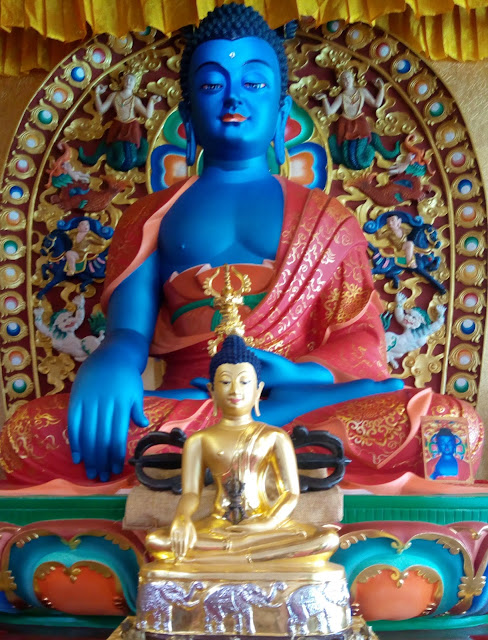- Especially powerful to liberate and purify all negative Karmas of our past, present, and future mind streams.
- It can liberate, not only the practitioner for fear of inauspicious rebirth, but other sentient beings as well.
- Effective in removing our outer, inner, and secret obstacles.
- Overcome our hatred and anger towards other sentient beings
- Repay our gratitude to our departed ones. Pray that they be free from suffering and be reborn in the Eastern Pure Land.
- Good health, happiness, decreased negative Karma, and increased wisdom for the living by the offering of auspicious lamps.
A journey to a mysterious Himalaya snow land and it's unique Vajrayana Buddhism and the threatening culture.
Saturday, June 11, 2022
Buddha Akshobhya Prayers
Sunday, October 8, 2017
The immovable one - Akshobhya Buddha 阿閦如来
Thursday, March 2, 2017
Ksitigarbha Bodhisattva 南無大願地藏王菩薩
- The first of these is arrogance, particularly toward one’s parents.
- The second is obstinacy, that is, refusing to listen to teachers and elders.
- The third is lack of diligence in honoring the Triple Gem.
- The fourth is thievery.
- The fifth reason for being born into poverty is accumulation of unpaid debts. Although money is false and empty, it cannot be used casually and wasted. To borrow money and not repay it, thinking that you have no obligation because money is of no true importance, will lead to rebirth as a servile and poor person.
Tuesday, June 28, 2022
Buddha Akshobhya - Long Mantra Prayers And Blessings
Tuesday, May 30, 2023
Kalachakra - The Manifestations of Cyclic Existence and Nirvana
- A generation stage where the primary concern is with the visualisation of oneself as a deity within the context of a mandala.
- A completion stage where the primary concern is with the purification of one’s winds and drops within the central channel, a process that culminates in the attainment of Buddhahood.
Regarding the outer or external aspect of conventional reality, the wheel of time refers to the passage of days, months, and years (as well as the cycles of the zodiac), while with regard to the individual or inner aspect, it refers to "the circulation of pranas [vital airs] within the wheel of the nadis [subtle channels] in the body," which is linked with the 12 aspects of dependent origination and the 12 signs of the zodiac. These different cycles are interconnected and correspond to each other.
In the first chapter, it is stated that the world emerges from emptiness and the force of time, which is a kind of power that originates the universe.
Because of time (kalat), from the voids (sunyesu), originate wind, fire, water, and the earth; the continents, mountains, and oceans; the constellations, the sun, the moon, the host of star-planets, and the sages; gods, bhutas, and nagas; animals that have four types of birthplace; humans and hell beings also, on the manifold earth and below; originate in the middle of the void (sunyamadhye), like salt in water, and the egg-born in the middle of an egg.
The nonduality of two facets of a single reality—namely, wisdom (prajña), or emptiness (sunyata), and method (upaya), or compassion (karuna). The word "time" refers to the gnosis of imperishable bliss (aksara-sukha-jñana), which is called a method consisting of compassion, and the word "wheel" designates wisdom consisting of emptiness. Their unity is the Buddha Kalacakra
Adi Buddha (the primaeval Buddha) The original Buddha Buddhist. The primordial force in the cosmos from whom the five Dhyani Buddhas arose. The embodiment of the concept of emptiness. He is considered by some authorities to be identical with Vaharaja and Vajrasattva. His image, sitting on a lotus leaf, is often carried by other Buddhist deities.
The Kalacakratantra summarises its fundamental doctrines in the following passage:
Identitylessness, the maturation of karma, the three realms, the six states of existence, the origination due to the twelve-limbed dependence, the Four Truths, the eighteen unique qualities of the Buddha, the five psycho-physical aggregates, the three bodies, the Sahajakaya, and animate emptiness. The system in which these are taught is the clear and definite instruction of the Vajri.
Wednesday, January 18, 2017
The Divine Manifestation - Sacred Mudras
- Bhumisparsa Mudra – “Gesture of the Earth Witness”.
- Dharmachakra Mudra - "Turning the Wheel of Dharma".
- Varada mudra - "Boon granting".
- Dhyana Mudra - "Meditation"
- Abhaya Mudra – “Protection, Reassurance and Blessing”
- Vitarka Mudra – “Gesture of Teaching, Giving Instruction“
- Tarjani Mudra – “Gesture of Warning”
- Karana Mudra – “Gesture to ward off the evil“
One finds this gesture often in depictions of Guru Rinpoche, Padmasambhava right hand is holding a Vajra that symbolize divine manifestation of gesture to ward off the evil forces.
- Uttarabodhi Mudra – “Gesture of Perfection“
In this Mudra, both hands are folded across the chest. The two index fingers touch each other and point upwards. The thumbs are interwoven. The remaining fingers encircle each opposite hand.
Thank you for reading, may you find peace and great bliss. With your support it helps to spread the Buddha’s precious teachings and turning the Dharma wheels in the world.
Aspiration For Bodhichitta
For those in whom the precious Bodhichitta has not arisen
May it arise and not decrease
But increase further and further.
Dedication of Merit
By this merit may we obtain omniscience then.
Having defeated the enemies wrong-doings.
May we liberate migratory from the ocean of existence.
With its stormy waves of birth, old age, sickness and death.
*Note
I do not own or infringe any copyright of these pictures.
Pictures courtesy and credit to the rightful distributors and or studios.
Pictures are intended for editorial use only.









































